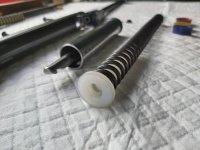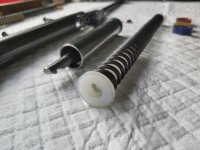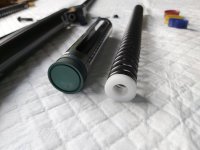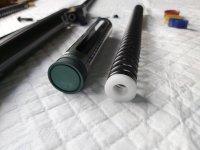Thanks for the comments and sharing your thoughts guys.
jmiller: When I first received the rifle it was doing low 770's with JSB 8.4s. Post tune it's now averaging low 780's (about 100 shots through so far), but its early days and the once the JM kit breaks in it'll likely gain some FPS. I did not use an OEM sleeve but a custom made .002" SS sleeve, so very lightweight/low mass.
KWK: The finish on the tophat was acceptable especially if you're not too picky or detail oriented but I feel it benefited greatly from a quick "polish". I like them flat and very smooth. The guide material isn't specified on ARH's website but I suspect its Delrin. Would like to take a peek at your Webley Stingray. I've been interested in finding a UK made Longbow as its one of the springers that was fruit of the Webley Venom Custom Shop, and has Venom DNA

.
JC: Thanks, agree the thin red pad is a nice compliment.
Broozer: Cheers and hats off to you for also working on your own guns, we become better airgunners through this experience. Re: piston seal fit size, how do I put this... It gets complicated

. To better answer your question lets consider mid power HW's in the 10.5-12fpe range, and use the 97 platform as a specific example due to the ease of accessing the compression tube when disassembled. In my experience, most aftermarket seals need at least a little sizing for an ideal fit. I pay close attention to touch the spinning seal lightly in a way that maintains its original angles. If you test the fit in a dry tube and without lube on the seal keep in mind that friction will be further reduced once your tube is burnished and your seal lubricated. I don't want it fitting too loose (more on this later) or too tight, it's a feeling that is hard to describe but you know it once you're there. It's hard to use the OEM seal resistance as a reference because based on the age of the rifle or if it's been mistreated the lubes can thicken and harden, giving the impression that the resistance is higher. The OEM seals can vary in size, too. But if you have a cleaned, freshly burnished tube and a good fitting OEM piston seal- then I think using similar resistance will put you in safe territory. Gabe, your 50s looks balanced with that ARH Apex muzzle brake (?)on your 50s.
One of CA's finest airgunners, that's YOU Lewis

:
Thanks bud you're too kind. But to answer your question: IF I were looking for high velocity numbers right off the bat; IF 100% of my shooting were done indoors or always in the exact same temperature; IF I intended to use one specific pellet weight/head diameter; IF I had a perfect and true compression tube, etc : then YES I
could use the method you described.

Weihrauch and a pizza

? 12 paces, open sights, standing.




